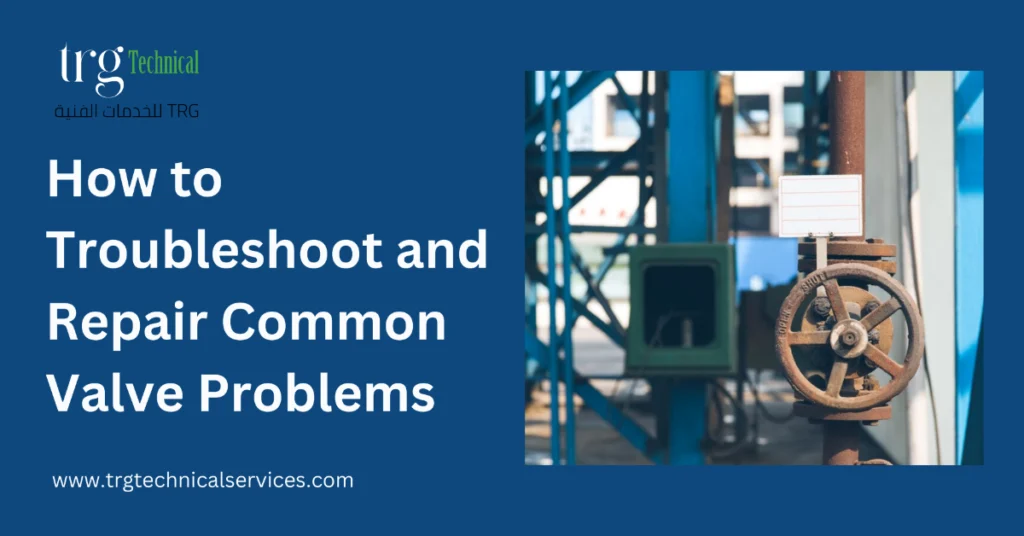How to Troubleshoot and Repair Common Valve Problems

Valves are an essential part of the control of liquids, gases, and other fluids’ flow in industrial processes. They form a key component of the oil and gas sector, power generation, manufacturing, and water treatment sectors. Nevertheless, as with any mechanical device, valves experience wear and tear, damage, and failure over time. Specialized valve repair work is important to ensure effectiveness, prevent downtime at huge cost, and ensure safety.
This article expounds on valve issues in general, troubleshooting tips, and means of repair so as to assist industries in advancing their operations while highlighting career opportunity for specialized technicians working in valve maintenance and repairs.
General Problems Encountered on Valves and Their Origin
1. Leaks (External or Internal)
Causes:
- Seal or gaskets becoming worn
- Erosion or corrosion
- Mistaking proper assembly procedure with loose fitters
- Pressure exerted greater than recommended
Failures led to seal because of overpressure
Troubleshooting & Fix:
- Inspect and exchange seals, gaskets, or packing should wear be the culprit.
- Inspect for corrosion and use protective coatings or replace the corroded components.
- Tighten fasteners with correct torque settings applied.
- Set pressure settings and run the valve within safe ranges.
2. Sticking or Jamming of Valve
Causes:
- Debris buildup in the valve body
- Rust or scale buildup
- Incorrect lubrication of moving parts
- Misalignment during installation
Troubleshooting & Repair:
- Clean the valve using a proper cleaning fluid to drain out dirt.
- Take apart and inspect for rust; use anti-corrosion treatment.
- Lubricate key components for correct operation.
- Realign or reinstall valve according to manufacturer instructions.
Related: Why Valve Maintenance Is The Key to Industrial Success
3. Refusal to Open or Close Fully
Causes:
- Faulty actuator
- Deposited material clogged flow path
- Defective valve stem or diaphragm
- Faulty control signals in automatic valves
Troubleshooting & Repair:
- Verify actuator performance and replace accordingly.
- Clean out and remove the valve to flush blockages.
- Verify valve stem or diaphragm for wear and replace accordingly.
- Verify control signals and calibrate automatic system.
4. Excessive Noise and Vibration
Causes:
- Cavitation caused by pressure imbalances
- Loose internal components
- High velocity of flow and consequent turbulence
- Worn bushings or bearings
Troubleshooting & Repair:
- Modify pressure setting to reduce cavitation effects.
- Secure or replace loose internal components.
- Modify valve size or install noise-reducing accessories.
- Inspect and replace worn bushings or bearings.
Related: How to Know When It’s Time to Replace a Valve in Your System
5. Valve Actuator Problems
Causes:
- Electrical failure in motorized actuators
- Loss of pneumatic or hydraulic pressure
- Actuator to valve misalignment
- Failure of internal components
Troubleshooting & Repair:
- Check electrical connections and replace defective wiring.
- Repair pneumatic or hydraulic line leaks.
- Realign and reinstall actuator properly.
- Replace any internal damaged components.
6. Corrosion and Material Degradation
Causes:
- Cavitation of corrosive fluids
- Poor material selection for operating conditions
- Failure to use protective coatings or maintenance
Troubleshooting & Repair:
- Inspect and apply corrosion-resistant coatings.
- Replace with more appropriate materials.
- Establish a routine maintenance program to prolong valve life.
Critical Tools and Techniques for Valve Fixing
To fix valves in an effective manner for troubleshooting, professionals utilize various tools and techniques, such as:
Diagnostic Equipment:
- Pressure and flow meters for monitoring valve performance
- Infrared thermography for hotspot and leak detection
- Vibration analyzers for measuring mechanical defects
Repair Tools:
- Torque wrenches for accurate bolt and fitting tightening
- Valve grinders and lapping machines for re-seating and re-sealing seats and seals
- Cutting equipment for replacing valve parts when necessary
Testing and Reinstallation:
- Hydrostatic testing to check leak-tightness after completion of repairs
- Functional testing in simulated operating conditions
- Calibration of automated valve systems for accurate control
Career Opportunities for Valve Repair and Maintenance
With growing businesses, the demand for skilled valve technicians rises phenomenally. Companies worldwide seek professionals who can diagnose, repair, and maintain industrial valves. The most significant career roles are:
1. Valve Technician
- Inspects, tests, and repairs valves in industrial settings.
- Ensures compliance with safety and performance standards.
2. Maintenance Engineer
- Develops preventive maintenance schedules for valve and piping systems.
- Increases efficiency and reduces downtime for operations.
3. Field Service Technician
- Performs on-site repair of emergency valves and troubleshooting.
- Coordinates with operators and plant engineers to ensure smooth operations.
4. Valve Automation Specialist
- Deals with automated control valves, actuators, and control systems related to them.
- Does calibration and programming for optimum performance.
These careers are accompanied by competitive salaries, job security, and opportunities for career growth in the oil and gas, power plants, and manufacturing plants sectors.
Conclusion
Successful troubleshooting and timely repairs are critical to the efficiency and longevity of industrial valves. Through the resolution of common issues such as leaks, actuator failure, and corrosion, industries can enhance safety, optimize performance, and reduce operating costs. For businesses looking for expert valve maintenance and repair services, TRG Technical Service offers specialized solutions for industry needs.
As demand for skilled valve technicians grows, career applicants with the right skills can secure rewarding jobs within the sector. If you’re an industry veteran or a potential technician, it’s time to invest in abilities that make industries run smoothly.
To discover more about professional valve service, visit TRG Technical Service and explore what employment opportunities and education are offered.


